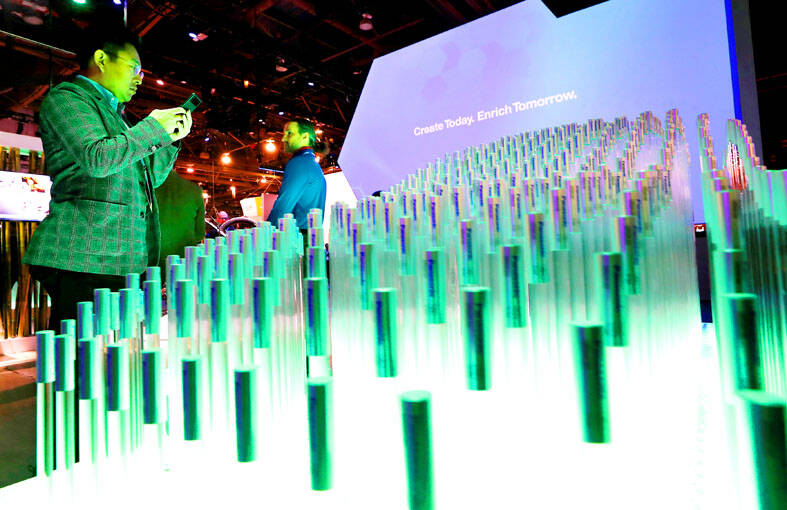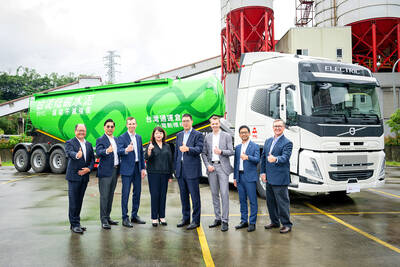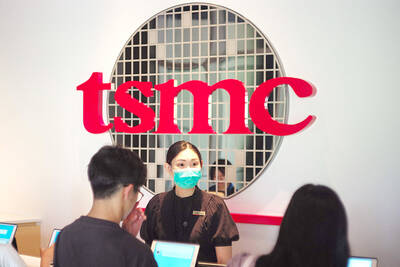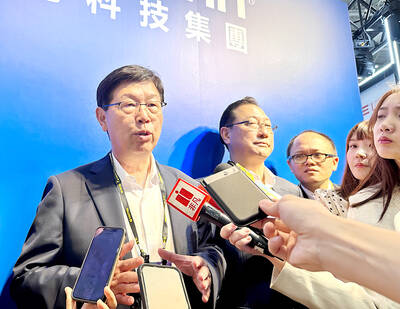The US and Japan yesterday announced a trade deal on electric vehicle (EV) battery minerals that is key to reinforcing their battery supply chains and granting Japanese automakers wider access to a new US$7,500 US EV tax credit.
The swiftly negotiated agreement prohibits the two countries from enacting bilateral export restrictions on the minerals most critical for EV batteries, senior officials in US President Joe Biden’s administration said.
The minerals include cobalt, lithium, nickel, graphite and manganese.

Photo: Reuters
The deal also aims to reduce US-Japanese dependence on China for such materials by requiring collaboration to combat “non-market policies and practices” of other countries in the sector and on conducting investment reviews of foreign investments in their critical minerals supply chains.
Minerals-focused trade deals are one way that the Biden administration hopes to open up access for trusted allies to the US$7,500 per vehicle EV tax credits in last year’s climate-focused Inflation Reduction Act.
Half of the credit for purchasing consumers is reserved for North American-assembled vehicles and batteries, a source of considerable tension with the EU, Japan and South Korea, who worry that their auto and battery makers might be rendered uncompetitive.
The other half of the credit is contingent on at least 40 percent of the value of critical minerals in the battery having been extracted or processed in the US or a country with a US-free trade agreement or recycled in North America.
Japan was working with the US to sign the agreement in Washington yesterday, Japanese Minister of Economy, Trade and Industry Yasutoshi Nishimura told reporters in Tokyo.
“As the demand for electric vehicle batteries is expected to grow significantly, securing important minerals essential for their production is an urgent issue,” Nishimura said.
The US Department of the Treasury is expected to define sourcing requirements for the EV tax subsidies by the end of this week, providing eagerly awaited guidance to the auto, battery and clean-energy sectors.
Asked whether the trade agreement would qualify Japan-sourced batteries, components and vehicles for that part of the tax credit, the US officials said that determination was up to the Treasury.
Nishimura said that EVs made with minerals mined or processed in Japan were expected to meet tax exemption requirements under the US act.
The Office of the US Trade Representative does not intend to seek approval from the US Congress for the minerals trade agreement, because it falls under the agency’s authority to negotiate sectoral trade agreements at the executive level, the US officials said.
However, they said provisions in the deal to promote labor rights and recycling in their battery mineral supply chains would help both countries.
“Japan is one of our most valued trading partners, and this agreement will enable us to deepen our existing bilateral relationship,” US Trade Representative Katherine Tai (戴琪) said in a statement. “This is a welcome moment as the United States continues to work with our allies and partners to strengthen supply chains for critical minerals, including through the Inflation Reduction Act.”
The two nations agreed to review the minerals agreement every two years, including whether it is appropriate to terminate or amend it.

Taiwan Transport and Storage Corp (TTS, 台灣通運倉儲) yesterday unveiled its first electric tractor unit — manufactured by Volvo Trucks — in a ceremony in Taipei, and said the unit would soon be used to transport cement produced by Taiwan Cement Corp (TCC, 台灣水泥). Both TTS and TCC belong to TCC International Holdings Ltd (台泥國際集團). With the electric tractor unit, the Taipei-based cement firm would become the first in Taiwan to use electric vehicles to transport construction materials. TTS chairman Koo Kung-yi (辜公怡), Volvo Trucks vice president of sales and marketing Johan Selven, TCC president Roman Cheng (程耀輝) and Taikoo Motors Group

Among the rows of vibrators, rubber torsos and leather harnesses at a Chinese sex toys exhibition in Shanghai this weekend, the beginnings of an artificial intelligence (AI)-driven shift in the industry quietly pulsed. China manufactures about 70 percent of the world’s sex toys, most of it the “hardware” on display at the fair — whether that be technicolor tentacled dildos or hyper-realistic personalized silicone dolls. Yet smart toys have been rising in popularity for some time. Many major European and US brands already offer tech-enhanced products that can enable long-distance love, monitor well-being and even bring people one step closer to

RECORD-BREAKING: TSMC’s net profit last quarter beat market expectations by expanding 8.9% and it was the best first-quarter profit in the chipmaker’s history Taiwan Semiconductor Manufacturing Co (TSMC, 台積電), which counts Nvidia Corp as a key customer, yesterday said that artificial intelligence (AI) server chip revenue is set to more than double this year from last year amid rising demand. The chipmaker expects the growth momentum to continue in the next five years with an annual compound growth rate of 50 percent, TSMC chief executive officer C.C. Wei (魏哲家) told investors yesterday. By 2028, AI chips’ contribution to revenue would climb to about 20 percent from a percentage in the low teens, Wei said. “Almost all the AI innovators are working with TSMC to address the

FUTURE PLANS: Although the electric vehicle market is getting more competitive, Hon Hai would stick to its goal of seizing a 5 percent share globally, Young Liu said Hon Hai Precision Industry Co (鴻海精密), a major iPhone assembler and supplier of artificial intelligence (AI) servers powered by Nvidia Corp’s chips, yesterday said it has introduced a rotating chief executive structure as part of the company’s efforts to cultivate future leaders and to enhance corporate governance. The 50-year-old contract electronics maker reported sizable revenue of NT$6.16 trillion (US$189.67 billion) last year. Hon Hai, also known as Foxconn Technology Group (富士康科技集團), has been under the control of one man almost since its inception. A rotating CEO system is a rarity among Taiwanese businesses. Hon Hai has given leaders of the company’s six